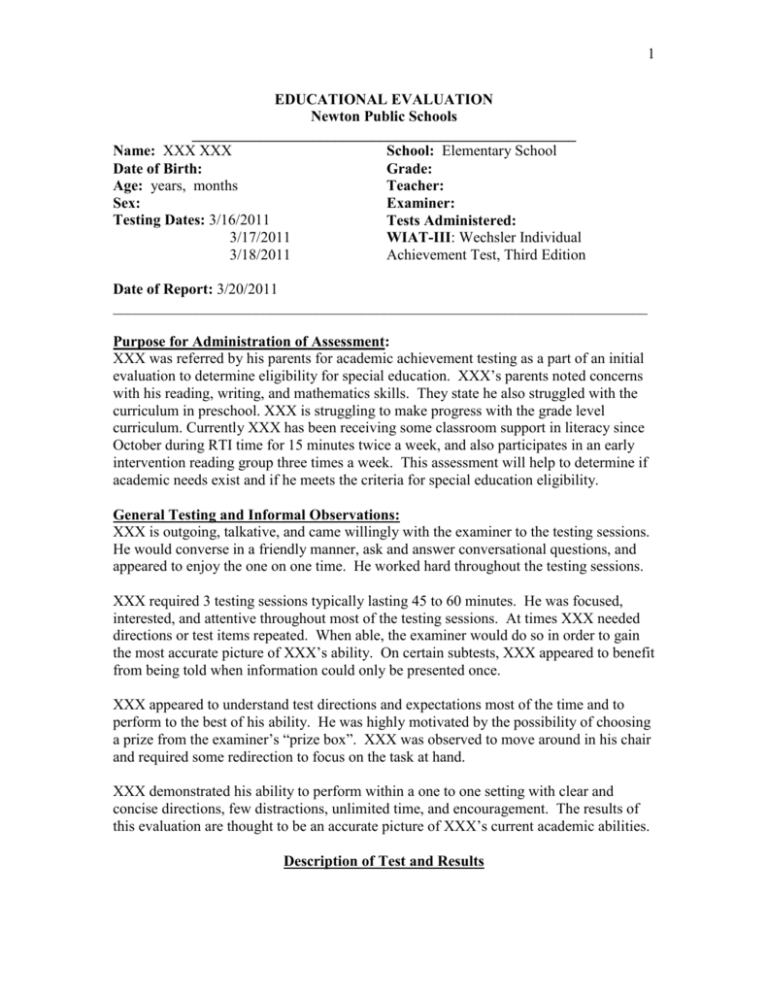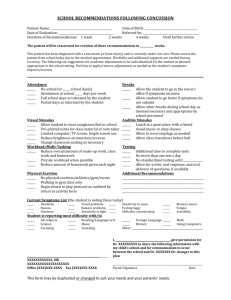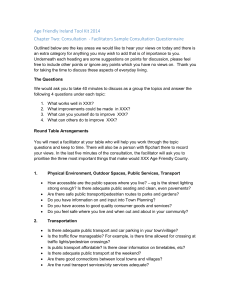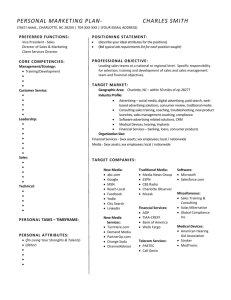WIAT-IIIstyle2 - Newton.k12.ma.us
advertisement

1 EDUCATIONAL EVALUATION Newton Public Schools ___________________________________________________ Name: XXX XXX School: Elementary School Date of Birth: Grade: Age: years, months Teacher: Sex: Examiner: Testing Dates: 3/16/2011 Tests Administered: 3/17/2011 WIAT-III: Wechsler Individual 3/18/2011 Achievement Test, Third Edition Date of Report: 3/20/2011 _______________________________________________________________________ Purpose for Administration of Assessment: XXX was referred by his parents for academic achievement testing as a part of an initial evaluation to determine eligibility for special education. XXX’s parents noted concerns with his reading, writing, and mathematics skills. They state he also struggled with the curriculum in preschool. XXX is struggling to make progress with the grade level curriculum. Currently XXX has been receiving some classroom support in literacy since October during RTI time for 15 minutes twice a week, and also participates in an early intervention reading group three times a week. This assessment will help to determine if academic needs exist and if he meets the criteria for special education eligibility. General Testing and Informal Observations: XXX is outgoing, talkative, and came willingly with the examiner to the testing sessions. He would converse in a friendly manner, ask and answer conversational questions, and appeared to enjoy the one on one time. He worked hard throughout the testing sessions. XXX required 3 testing sessions typically lasting 45 to 60 minutes. He was focused, interested, and attentive throughout most of the testing sessions. At times XXX needed directions or test items repeated. When able, the examiner would do so in order to gain the most accurate picture of XXX’s ability. On certain subtests, XXX appeared to benefit from being told when information could only be presented once. XXX appeared to understand test directions and expectations most of the time and to perform to the best of his ability. He was highly motivated by the possibility of choosing a prize from the examiner’s “prize box”. XXX was observed to move around in his chair and required some redirection to focus on the task at hand. XXX demonstrated his ability to perform within a one to one setting with clear and concise directions, few distractions, unlimited time, and encouragement. The results of this evaluation are thought to be an accurate picture of XXX’s current academic abilities. Description of Test and Results 2 Wechsler Individual Achievement Test, Third Edition (WIAT-III) The Wechsler Individual Achievement Test- Third Edition (WIAT-III) is a standardized, individually administered and nationally normed clinical instrument designed to measure the achievement of students who are in grades Pre-kindergarten through 12. The WIATIII consists of 16 subtests used to evaluate listening, speaking, reading, writing, and mathematics skills. Not all subtests are given for each age group; please refer to subtest names in the table below for subtests administered based on students’ current age or grade. The percentile rank means that the student did the same or better than ___% of the population of children that took the test. Score norms based on Age Subtest/Subtest Component* Listening Comprehension *Receptive Vocabulary *Oral Discourse Comprehension Early Reading Skills Math Problem Solving Alphabet Writing Fluency Numerical Operations Oral Expression *Expressive Vocabulary *Oral Word Fluency *Sentence Repetition Spelling Composite Oral Language Written Expression Mathematics Total Achievement Standard score Percentile Rank Classification 103 116 90 58 86 25 Average Above Average Average 83 91 85 13 27 16 Below Average Average Average 87 86 83 94 89 84 19 18 13 34 23 14 Average Average Below Average Average Average Below Average Standard Score 93 82 88 85 Percentile Rank 32 12 21 16 Classification Average Below Average Average Average XXX’s total test score of 85 places him in the lower end of the average range for a child his age. His composite scores in oral language and mathematics are in the average range, and his composite score in written expression places him in the below average range in comparison to his age based peers. XXX’s strongest scores were in the area of oral language. His highest score on the evaluation emerged in this area on the receptive vocabulary subtest. On this subtest, XXX was given a vocabulary word and showed four pictures. He then had to pick the 3 picture that matched the vocabulary word. There were a couple of items in which XXX guessed at the picture and gave the correct answer. He said, “I don’t know, so I’ll just pick this one”. A few times the examiner asked XXX what the word meant to see if he was making a lucky guess or if he really knew what the word was, and he was able to give a relatively accurate definition. For example, after he choose the correct picture for the word ‘astounded’, the examiner asked him what it meant and he said “um….surprised”. When asked about ‘currency’ he said “money” and ‘identical’ he said “2 of the same”. XXX’s weakest composite score was in written expression, and his lowest subtest scores were on the early reading skills and expressive vocabulary subtests. On the early reading skills subtest, XXX lost points because he was not able to correctly identify the lowercase letters u, d, and g. He struggled to choose words that had the same ending sounds, and putting words together when given parts (for example, when given /sh/ /ell/, XXX said “shoes”). He was also unable to choose letter groups (blends or digraphs) that made specific sounds, and reading simple words and matching them to pictures. His low score on the expressive vocabulary subtest could be affected by XXX’s impulsive answers at times. For this subtest, XXX was presented with both a visual and auditory cue in which to provide a vocabulary word. For example, XXX was shown a picture of a baby crawling and told, “Tell me the word that means to move on hands and knees”. XXX answered “Baby”. It is unclear if XXX was simply naming the picture he saw or if he really did not know the word that means to move on hands and knees. He did this with 3 other test items, naming the picture as opposed to answering the verbal prompt. Even with some subtests scoring below average, XXX’s overall total test score shows him to be performing at an average level, although on the lower end of the average range, when compared to peers his age. Based on this test, academically XXX appears to be stronger in the area of mathematics than reading and writing. Evaluation Summary and Implications XXX is a 6-year-old friendly and talkative kindergarten student at Burr Elementary School who enjoys looking at books and Star Wars. XXX was referred by his parents for academic achievement testing as a part of an initial evaluation to determine eligibility for special education. They noted concerns since preschool with XXX’s inability to recall and grasp the academic curriculum. This assessment will help to determine if academic needs exist and if he meets the criteria for special education eligibility. XXX currently attends a regular education classroom and has been receiving some additional support in literacy since October through RTI twice a week and early intervention three times a week. XXX is struggling to make progress with the grade level curriculum in most areas. XXX was administered the Wechsler Individual Achievement Test- Third Edition (WIAT-III). On the WIAT-III, oral language emerged as a strength for XXX. Composite scores in oral language and mathematics place him in the average range in comparison to students his age. XXX’s written expression composite score places him in 4 the below average range for a student his age. XXX's total composite score of 85 on the WIAT-III places him in the lower end of the average range for a child his age. Recommendations Based on the findings of this evaluation, the following recommendations may be beneficial to promote XXX's academic success. 1. XXX may benefit from being allowed to work on tests and assignments at his own pace, without time restrictions. 2. XXX may benefit from small group focused instruction during reading, writing, and mathematics. This instruction should incorporate different modalities to ensure adequate understanding and retention of skills including direct phonics instruction, guided reading, spelling, comprehension, and specific writing skills, math concepts, calculation, and problem solving skills. 3. XXX should receive frequent prompting and check-ins during writing tasks. Alphabet charts with pictures and letters, talking out loud before writing, word banks, and other aids may be of benefit. 4. Frequent repetition and review of concepts and skills previously taught should be incorporated into XXX’s schedule to ensure adequate comprehension and retention of skills. 5. Incorporate the use of visual charts, models, and exemplars for him to refer to when presented with new or novel information. 6. XXX may benefit from a warning to increase his attention when important directions or information is about to be delivered. This assessment should be reviewed by the team in conjunction with other reports as well as classroom achievement and accommodations to determine if academic needs exist and if he meets the criteria for special education eligibility. More specific recommendations will be discussed at the upcoming team meeting. It has been a pleasure working with XXX. If you have any questions regarding this assessment, please feel free to contact me at 617-559-. ______________________ Learning Center Teacher 5 Wechsler Individual Achievement Test, Third Edition (WIAT-III) The Wechsler Individual Achievement Test- Third Edition (WIAT-III) is a standardized, individually administered and nationally normed clinical instrument designed to measure the achievement of students who are in grades Pre-kindergarten through 12. The WIAT-III consists of 16 subtests used to evaluate listening, speaking, reading, writing, and mathematics skills. Italicized subtests were administered to this student. Composites are made up of Subtests: Oral Language composite: Listening comprehension: 2 components: Receptive Vocabulary, Oral Discourse Comprehension Oral expression: 3 components: Expressive vocabulary, oral word fluency, sentence repetition Total Reading Composite: Word reading Pseudoword decoding Reading Comprehension Oral reading fluency Basic Reading: Word Reading Pseudoword Decoding Reading Comprehension and Fluency: Reading Comprehension Oral Reading Fluency Written Expression: Alphabet Writing Fluency Spelling Sentence Composition: 2 components: sentence combining, sentence building Mathematics: Math Problem Solving Numerical Operations Math Fluency: Math Fluency Addition Math Fluency Subtraction Total Achievement Composite: All the above subtests plus Early Reading Skills






